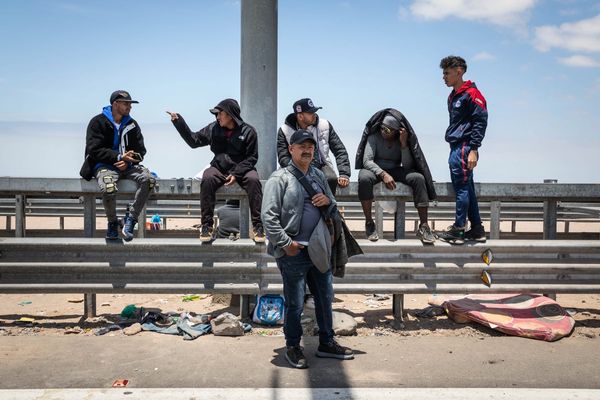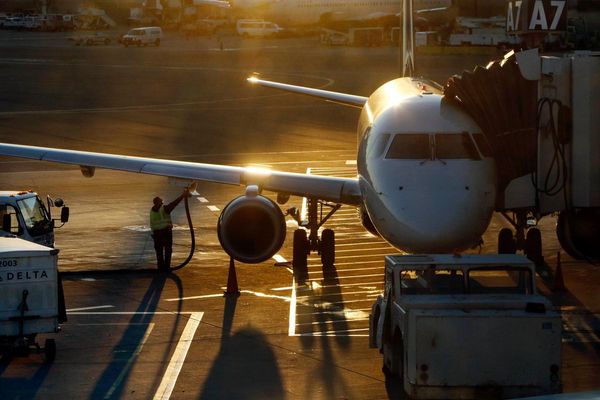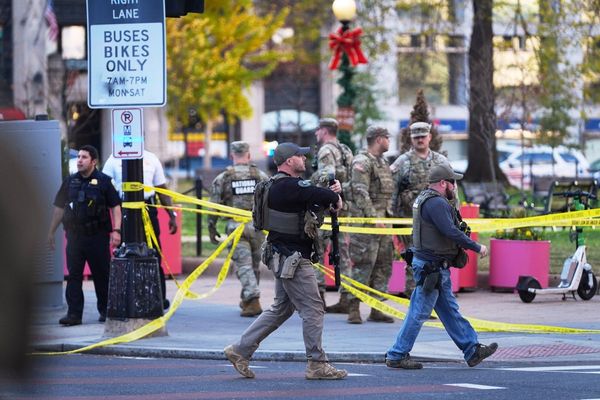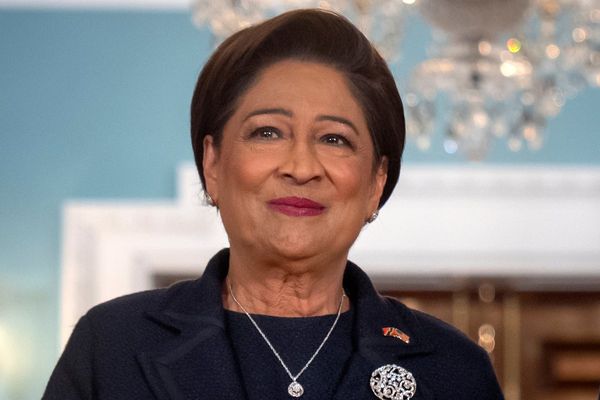
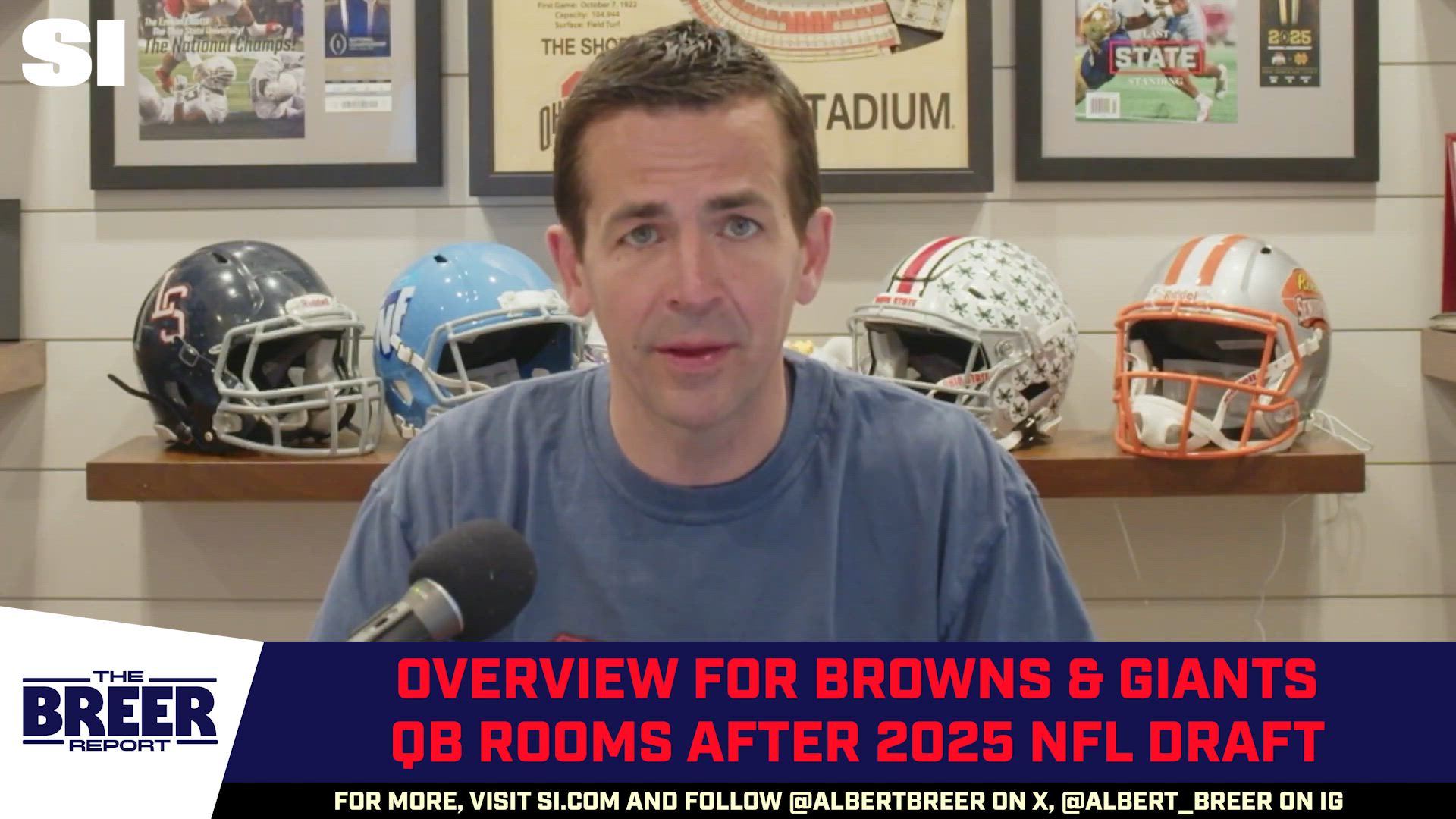
It may be a bit much to say Joe Schoen set out, after Daniel Jones tore his ACL in 2023, to find the next Josh Allen. Those aren’t easy to get. But the New York Giants’ GM was with the Bills as GM Brandon Beane’s No. 2 when Buffalo deftly moved up the draft board, through a slew of corresponding moves, to land Allen with the seventh pick seven years ago.
So 2018 isn’t a bad point of reference for him.
And one moment in that process that Schoen specifically recalled, as he and I talked last week, was flying to Wyoming to work Allen out that March, as the Bills got religion on this cyborg of a quarterback in a way that had little to do with how he threw a football.
“To me, part of our process is just having these people, the kids, communicate with us,” Schoen says. “Can they do it themselves? Can you set up a dinner? Can you make sure the video guy is there to record the pro day? Can you make sure you have receivers there to run routes? Like, those are simple things that you and I would be like, Yeah, no problem. So do you need somebody to do that for you? Are you independent?”
Emphatically, if inadvertently, Allen let the Bills know.
He was flying from Fresno to Denver for the workout. He had a buddy set to pick him up and drive him the two hours from the Denver airport back to the Laramie, Wyo. campus. He got delayed. The crew planned to get steaks at the Cavalryman, a century-old chophouse near campus, but they were closing at 9 p.m.
Everything seemed up in the air. Or so the Giants thought. Allen had it covered. His buddy waited him out at the airport. They came in on two wheels around 9. The Cavalryman had already been called and, just for them, stayed open until 11.
“We were the only people in the place for two hours,” Schoen says. “And the fact that his college roommate drove that length of time, waited for him at the airport when he was delayed, brought him back up, and then, this restaurant that we’ve never been to, we don’t know any of the people, were nice enough to stay open? To me, that just said a little something about Josh. Those people were willing to do that for that kid.”
Those are the sorts of moments Schoen and the Giants sought out over the past 18 months, looking high and low for guys who had some of the same qualities Allen once showed the New York GM. They were also looking, obviously, for the requisite talent to win at the position.
After all that time, thousands of private jet miles logged, and Saturdays spent in college towns and meetings, New York landed on Ole Miss’s Jaxson Dart 11 days ago.
Today, Schoen will tell you the story of how they got there.
The NFL draft is over, but we’re still covering it. So in the takeaways this week we’re going to circle back to it, and also look forward a bunch. We’ve got …
• An explanation on why it’s too early to anoint Arch Manning.
• A dive into how the Atlanta Falcons landed two of top-five talents (by their estimation) in the draft.
• How the San Francisco 49ers may have stolen a freak-show pass rusher.
And a whole lot more. But we’re starting with the Giants’ journey to Jaxson Dart.

This long road the Giants have traveled could’ve been a whole year shorter had the Patriots been a little more receptive to their trade offers in April 2024. And in a way, New York’s affection for Drake Maye—the target of those trade overtures—last year helped kick off the Giants’ process two months later.
Over the past three summers, Schoen has taken his son to the Manning Passing Academy in Louisiana in June. As luck would have it, the younger Schoen drew Maye as his counselor two years ago. So the older Schoen got a front-row seat to see Maye, the person. He saw a collegiate star who coached the kids hard, bringing energy every day. He was engaged, and, in so many ways, it showed Schoen who Maye was.
Schoen filed it away, not really thinking he’d try to get him 10 months later—the Giants, at that point, were only a few months removed from signing Jones to a four-year, $160 million deal. Schoen returned to Louisiana for the 2024 MPA, now knowing he’d likely be looking to draft a quarterback in ’25, with an ulterior motive.
“It’s the franchise quarterback,” Schoen says. “And how they interact [there], that translates to how they interact with fans after games or teammates at practice. Or how they’re going to treat kids and family within the team. That’s all important. It’s what you want in that position. So you’re really evaluating everything they do, and projecting that to what it’s going to look like in the NFL.”
Schoen saw Dart throw the ball and took the mental note as he looked at all the guys that the third-year-starter-to-be spun as well as any of the other college guys there. He also saw how Dart was, in the GM’s words, “one of the fellas” alongside the other quarterbacks.
And with that box checked, and training camp approaching, the process hit another gear.
The first phase of the plan would be to get personnel guys out to fall camp at the big programs and to get eyes on the quarterbacks in a practice setting. It’s normal for scouts to hit the road hard then because the access at most schools is better in August than it is after the season starts. But in this case, with the staff having already studied the previous year’s tape and the quarterback need apparent, there was a special focus to the effort.
Then, there was the travel plan for the fall.
It was ambitious—and also important—for the Giants to see as many as they could live, given the uncertainty over which quarterbacks would step forward and become the top guys for 2025. Ownership was willing to invest, giving Schoen & Co. access to a jet, so they could go where they needed to go Saturday and get back to the team in time for games, regardless of where they were, on Sunday.
So, through the fall, Schoen saw Dart, Texas’s Quinn Ewers, Ohio State’s Will Howard, Syracuse’s Kyle McCord, Alabama’s Jalen Milroe, Colorado’s Shedeur Sanders and Miami’s Cam Ward in game settings (and most of them in practice settings, too), and also three more guys who didn’t wind up declaring—Penn State’s Drew Allar, Georgia’s Carson Beck and LSU’s Garrett Nussmeier—live.
But he was careful about visiting one school and, interestingly enough, it was Ole Miss.
Schoen was sensitive with that one because his daughter is a student there, and he didn’t want his staff to think he was using the quarterback project for personal reasons.
“In hindsight, I’m like, I could have definitely spent more time with my daughter this fall,” he joked. But he did eventually get to Oxford for the Egg Bowl over Thanksgiving weekend. And when he got there, as with all the quarterbacks, Schoen trained his eyes on Dart’s every move—particularly what he was doing when he wasn’t on the field.
On the Vaught–Hemingway Stadium sideline, Dart gave Schoen everything he needed to see.
“What really stands out about Jaxson is his passion for the game, leadership amongst his teammates and how he can cross sides of the ball.” Giants GM Joe Schoen
“What really stands out about Jaxson is his passion for the game, leadership amongst his teammates and how he can cross sides of the ball,” Schoen says. “Like, he’s not just sitting over with the offense the entire time. You see him interacting with the defense as well. That’s a big part of the live exposure—you have a bad throw, or you have a three-and-out, you come over to the sideline, who are you interacting with? Which coaches? Are you talking to your receivers? Are you talking to your line? Are you by yourself? Are you not?
“You get back up, go to the sideline and watch the defense out there. Those are all things that we’re watching and evaluating.”
The interesting thing, too, was how intentional that leadership was from Dart.
A couple of years back, ex-NFL coordinator and Notre Dame coach Charlie Weis was visiting Ole Miss, where his son Charlie Jr. is Lane Kiffin’s offensive coordinator. He was in a quarterbacks meeting, and afterward, Dart sought him out and asked what it would take to be an NFL quarterback. Weis responded that Charlie Jr. and Kiffin had the football stuff covered, but he’d give him a story on leadership.
Weis told Dart that he’d seen Tom Brady, as a young player, purposefully build relationships with players all over the roster—rather than just bond with his offensive linemen or receivers. That, Weis continued, facilitated Brady’s leadership, and it was something Dart could work on right away.
Clearly, he had.
Once the season ended, the Giants’ quarterback plan continued with the normal trips to all-star games, and New York had an ace up its sleeve on that one—with offensive coordinator Mike Kafka having volunteered to be a head coach in the Senior Bowl.
Kafka was assigned to the National team, which had Oregon’s Dillon Gabriel, Louisville’s Tyler Shough and Wilford Laurier’s (Waterloo, Ontario) Taylor Elgersma as its quarterbacks. But he also had access to meeting time with the American team’s quarterbacks, those being Notre Dame’s Riley Leonard, Milroe and Dart.
“They’re in installs with these guys, the coaches share information, they share a meal room,” Schoen says. “They’re around these kids a lot when their guard’s down and they don’t think anybody’s watching—so, yeah, it’s a competitive advantage, if you get buy-in from your coaches, and they’re willing to give up their free time to go help the organization.”
The result was Kafka seeing a lot of what Schoen did last summer and again in Oxford—Dart had a magnetism to him to connect with people and fit in as one of the guys.
From there, the Giants punched the accelerator, with pre-combine draft meetings followed by interviews at the combine itself with all the quarterbacks. Schoen wanted to have as much information in place as possible before free agency started, mostly because he knew, at quarterback, his free-agent plan would be affected by where they were draft-wise—and there was another lesson, too, from Buffalo marking that.
Interestingly enough, it was also from that private workout of Allen in Laramie, Wyo.
“Indianapolis and the Jets made that trade where they swapped [picks] three and six,” Schoen says. “Well, we were just then doing a private with Josh. We hadn’t met with [Josh] Rosen. We hadn’t met with [Sam] Darnold. We didn’t have all the information yet, so we couldn’t make a move.”
The result wasn’t horrible. But it could have been. With that year’s Giants unwilling to move, Saquon Barkley in their sights, and the Browns at No. 1 and Jets at No. 3 resolved to take a quarterback, the best Bills would be able to do is land the third quarterback. And while good fortune had the Browns and Jets passing on Allen, relying on such an outcome again wouldn’t necessarily be prudent.
So they lined up the quarterback 30 visits for the week after the combine.
Dart, Sanders and Ward were among the early visitors to East Rutherford. The Giants took Dart out in Hoboken his first night, gave him an install for the next day and, over dinner, discussed the information they’d cover at the facility. And it was the same for Sanders and Ward, and later Milroe and Shough, so they could make apples-to-apples comparisons.
“Everybody has a different way to learn,” Schoen says. “So if you know how you learn, and what you need to do to get the information to be able to execute it, that’s part of the process, too. Does this person know how to teach himself new material, and then be able to execute it, regurgitate it and talk about it the following day? Jaxson did a really good job with it. He had his process to lead him to that point—all these guys are trying to figure that out. …
It was important, too, with Dart because of the perception held by scouts, and teams as a whole, that the Baylor-influenced spread offense that Kiffin was running was simplistic for the quarterback. That didn’t mean Dart couldn’t learn to run something more complex. It just meant he hadn’t been asked—or at least that was the perception.
What the Giants figured out as they went along was that Kiffin had started to reincorporate some older-school West Coast concepts into his offense, his roots, because Dart could handle it.
Dart also agreed to work out before his pro day after the team finished up the first wave of free agency.
Meanwhile, other pieces were coming together. The Tennessee Titans shot down New York’s overtures to trade up to the top pick. And with that piece of clarity, and the emergence of Penn State’s Abdul Carter and Colorado’s Travis Hunter as the draft’s top two players, the Giants wanted to create a scenario where they weren’t cornered and had to overextend to get a quarterback. So they added both Russell Wilson and Jameis Winston as bridge guys.
Meanwhile, the process steadily moved forward with Dart because of the earlier juncture of his workout. The Giants set up a Zoom in the days before their first of two trips to Oxford, adding more information to the initial install they’d given Dart. Then, when they got back to Mississippi—in the meeting room—they drilled him to see how he’d retained it.
Another part of the workout was to have the quarterback arrange dinner for the night before. Dart picked Saint Leo, which happened to be the restaurant in Oxford that Schoen was most familiar with—and while the GM and quarterback’s mutual affection for the Italian spot wasn’t any sort of deciding factor, it sure didn’t hurt.
As for the on-field workout, that was another apples-to-apples piece of the process. They had Dart do precisely as the other quarterbacks, and Dart threw the ball well in comparison to his peers.

After Dart’s pro day back in Oxford, the Giants came back for final draft meetings. At that point, it became clear that they wouldn’t be picking a quarterback at No. 3, given that Hunter or Carter would be on the board when New York hit the clock. With the presumption that Ward would go to the Titans with the first pick, and Hunter would go second (at the time, almost everyone thought it’d be to the Cleveland Browns), the Giants zeroed in on Penn State’s star rusher.
“It’s the draft, you’re trying to find the best player available,” Schoen says. “And you can’t have enough rushers. He’s jumped off the film since his freshman year. He was playing off the ball. Wearing the No. 11 [made famous at PSU] and moving at a different speed than everybody else. Then, for a first-year guy fighting off the edge [in 2024], the production you have, how disruptive he is, the explosion, and then, the ability to affect the quarterback and the versatility to play off the ball. It’s hard to find a guy that can impact the games like that.”
They’d done a 30 visit with Carter, too, vetted his shoulder and foot issues (the doctors were O.K. with it), and had Daboll go to State College to meet with Carter, which helped to ease some character concerns other teams had with the prospect.
Even that was the result of a lesson Schoen took from the 2018 experience.
In the build-up to that draft, Beane told the staff the story of the Carolina Panthers’ 2011 draft. The team, he said, was so focused on vetting Cam Newton, whom they’d take with the first pick, that the rest of the draft got neglected. The result was that the other seven Carolina picks in that draft after Newton went first played in a combined 53 games for the team, with 24 starts. All were gone from the Panthers by the middle of ’13.
Beane was determined not to let that happen again.
“It was like, Hey, we’re going to study the quarterbacks, but we got to nail this draft,” he said. “And if you go back to the 2018 draft for the Bills, it was really good. I mean, Wyatt Teller, Taron Johnson, Tremaine Edmunds, Harrison Phillips, Ray-Ray McLeod and Siran Neal. It was a really good draft. And, so, that was my focus, too. It wasn’t just like, Hey, we got to exhaust our resources and make sure we do a deep dive on these quarterbacks, but we got to get the rest of the draft right, too.
“So taking that all into account, it was busy. You want to get every draft right, obviously, but you are spending an exorbitant amount of time on a certain position …”
The easiest, best way to get there then was to do the obvious and take Carter. And after one final swing of private workouts—to Boulder to work out Sanders, Tuscaloosa to work out Milroe and Louisville to work out Shough on April 17, 18 and 19—the Giants reconvened to cement the plan to take Carter and discussed what would come after that.
And in a way, those next steps would be presented to the Giants as much as they pursued them themselves. Everyone assumed Schoen would try to trade up, so New York got calls from teams starting in the late teens all the way through the bottom of the first round saying, “We’re willing to move back.”
By then, the Giants circled three teams they thought could take a quarterback, or even move up for one—Pittsburgh at No. 21; the Browns, after the trade down from No. 2 to No. 5, had capital to come up from Nos. 33 or 36; and the New Orleans Saints had a history of moving up and a need. And with many trade-up options out there, the Giants had four guys targeted that they were willing to trade back into the first round from No. 34 for, with Dart being the quarterback option.
Once the Steelers took Oregon DT Derrick Harmon rather than a quarterback at 21, Schoen picked up the phone and got aggressive. His goal was to land Dart, while hanging onto the 65th pick, because he felt like that one was smack in the heart of the strength of the draft.
The Texans had done a lot of work on Ohio State G Donovan Jackson. Whether they were planning to take him at 25 or not is unclear. Either way, after Jackson went 24th to the Minnesota Vikings, dialogue between Schoen and Houston GM Nick Caserio got more serious. With the Texans on the clock, the two were going back and forth on proposals. The Giants put the 99th pick on the table, the comp, presumably, they got for losing Barkley last year. The Texans needed a sweetener, so Schoen threw in next year’s third-round pick.
And with that, the Giants made the call to finally end their year-long quarterback search.

There was a metaphorical exhale for Schoen after he hung up with Caserio, for sure.
It’s been a bumpy road getting to where the Giants were late on Thursday night, finishing off the draft’s first night with Carter and Dart in hand. Most of all, though, Schoen was happy for the guys in his department who invested so much in getting the pick right.
“When we go to camp in July, we really don’t stop until after the draft,” Schoen says. “The coaches, January, season’s over, their schedule gets a little bit lighter until the players come back. So, for us, it’s just been a long year. Three-win season, long offseason going through all of the quarterback process and everything else. And to get a guy that we were fired up about and convicted in, and we didn’t have to give up a lot of resources, it was pretty relieving for me at the time.”
Then, like he’d promised he would, he went back to work.
The 65th pick proved to be, at least on paper, really valuable, with Toledo DT Darius Alexander, whom some once believed could go in the first round, still there. The Giants then kicked off Day 3 picking Arizona State RB Cam Skattebo three picks in, and well-regarded Purdue OL Marcus Mbow, who could fill a big hole at guard, in the fifth round.
So this draft isn’t only about one or two players. Or the Giants hope it won’t be.
That said, Schoen knows the score here, too. He knows where he and his regime are in their time running the Giants. Getting the Carter pick right would be huge. It’s easy to argue that getting the next one after that right is even bigger. And the work the team’s done fully reflects that. It’s weighed on everyone, as it should.
“We’ve got boots on the ground everywhere,” Schoen says. “We’d already coached in a game and been around Jaxson before February 1. So it’s a collaborative approach with Dabes and his staff. We’ve done these private workouts going back a year ago. We worked J.J. McCarthy out on Easter. And this year, we’re on the road Easter weekend [for Sanders, Milroe and Shough] again. So it’s a huge sacrifice.
“But we’re all on the same page, the coaching staff, the personnel staff, that the collaboration and the detailed process, typically, it will lead you to making really good decisions. And we’ll see how it plays out. We’re happy we were able to get him.”
Because of the moments they’ve had with him, such as the one Schoen once experienced with Allen, the Giants feel good they’ve got the right kind of guy to play in New York and capably play the position.
Now, Schoen, Daboll & Co. just need him to be the right quarterback, too.
This article was originally published on www.si.com as How the Josh Allen Process Led the Giants to Jaxson Dart.

